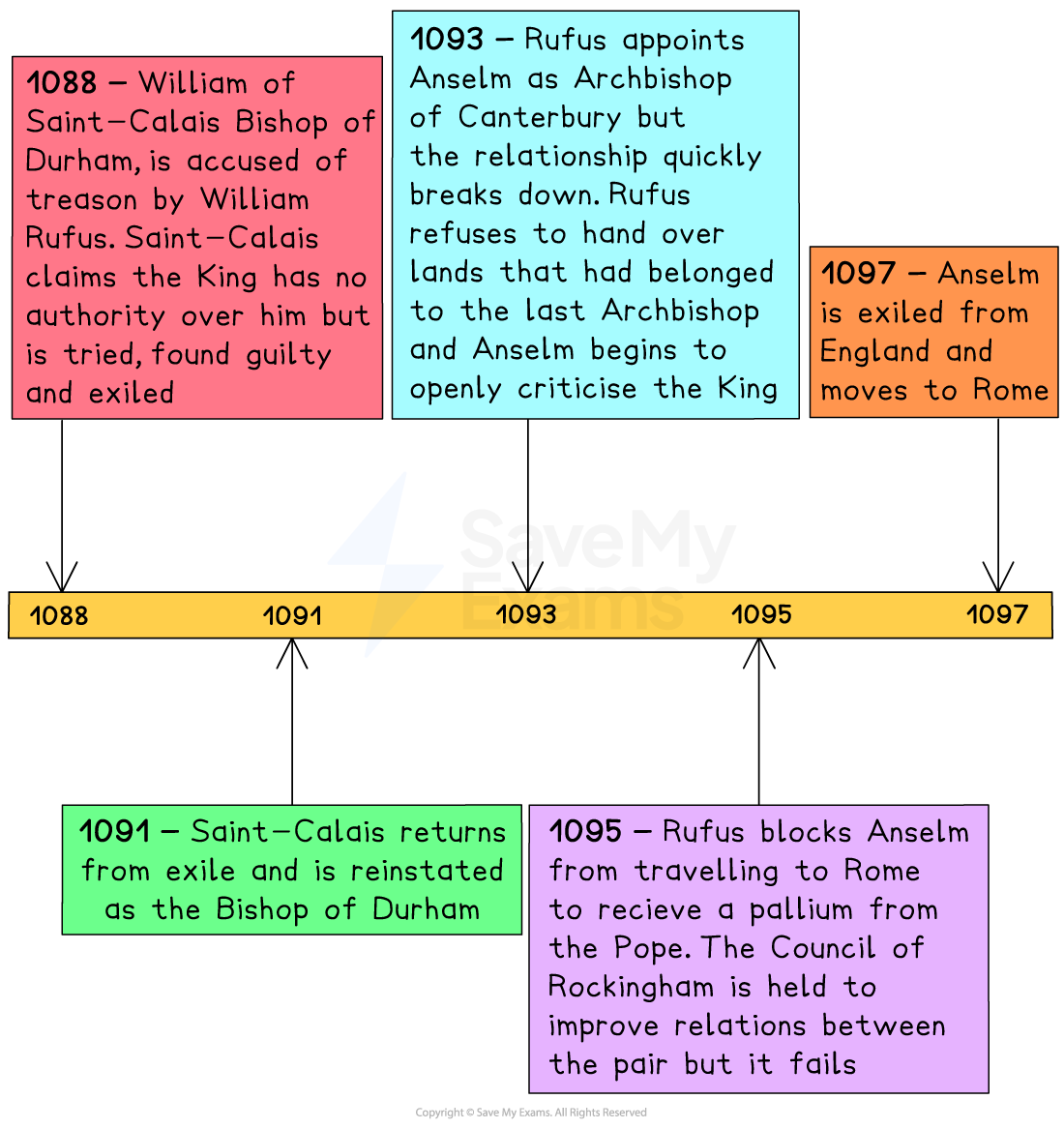William II & the Church (AQA GCSE History): Revision Note
Exam code: 8145
Timeline & Summary

William II, also known as William Rufus, had a troubled relationship with the Church. The first clash was over the King’s authority to punish members of the Church. When the Bishop of Durham was accused of treason in 1088, Rufus proved his authority by stripping the bishop of his post and exiling him. The second conflict centred around Rufus’ choice for Archbishop of Canterbury in 1093. Anselm agreed to become Archbishop if Rufus agreed to certain conditions. When Rufus fails to do this, Anselm starts to criticise the King publicly. Rufus then prevented Anselm from travelling to Rome to visit the pope. The Council of Rockingham was held in 1095 to settle the differences between the King and the Archbishop and, in 1097, Anselm was exiled from England.
Conflict with William of Saint-Calais, 1088
In 1088, William of Saint-Calais, the Bishop of Durham, informed William II (Rufus) of a rebellion against him
Saint-Calais agreed to send soldiers to help Rufus suppress the rebellion
When Saint-Calais failed to send the promised reinforcements, Rufus charged him with treason
Saint-Calais claimed that Rufus’ courts had no authority over him
As a member of the clergy, he believed he should be tried in a Church court
Rufus argued that Saint-Calais had broken his oath of fealty
As he had broken his oath to the King, it should be the KiIng’s court that tried him
Saint Calias stood trial in a secular court in Salisbury in November 1088
The trial lasted a single day and Saint Calais was found guilty of treason
He was stripped of his bishopric and sent into exile
Saint-Calais was allowed to return and reinstated as Bishop of Durham in 1091
However, Rufus had established his authority over Saint-Calais
He’d also shown other bishops what would happen if they dared to challenge him
Conflict with Anselm, 1093-94
When Lanfranc, the Archbishop of Canterbury, died in 1089, Rufus deliberately delayed naming his successor
This was so all of the rents and profits from the large amount of land held by Lanfranc would go directly to the King instead
In 1093, Rufus fell seriously ill and believed the sickness was a punishment from God for not appointing a new Archbishop of Canterbury
As a result, he chose Anselm, the Abbot of Bec monastery and former pupil of Lanfranc to become the new Archbishop
Anselm only agreed to take on the role if certain conditions were met:
all land that had previously belonged to Lanfranc was to be returned to the Church
Anselm had to become the King’s personal spiritual advisor
the king had to recognise Urban II as the pope formally
Rufus agreed to all of the conditions apart from returning the lands
The king was concerned about the loss of income this would cause
This meant that relations between Rufus and Anselm were tense from the very start
Things worsened when Anselm started openly criticising the king’s morality and holding of Church lands in his sermons
The Council of Rockingham, 1095
When Anselm prepared to travel to Rome to receive a special robe or vestment from the pope called a pallium, Rufus blocked him from leaving
Rufus wanted to reduce the power and influence of the pope in England
Rufus believed Anselm receiving the pallium would symbolise his allegiance to the pope over him
To settle the dispute, the Council of Rockingham was held in 1095
Although a truce was called, the Council failed to find a solution that both sides would agree on
The pallium was eventually collected from Rome by a messenger and presented to Anselm in England
The bad feelings between the king and the Archbishop continued
Rufus blocked Anselm’s attempts to change and reform the Church in England
Anselm delayed paying the taxes or providing the knights to Rufus that were expected from a tenant-in-chief
In 1097, relations broke down completely and Anselm was exiled from England and moved to Rome
Rufus continued to profit from the income from the lands that Anselm had left
The issue of simony
One of the main criticisms of the Anglo-Saxon Church had been the practice of selling roles and positions - known as simony
Simony had been ended under William I as part of the reforms of Archbishop Lanfranc
William Rufus was keen to both increase his wealth and reduce the influence of the pope in England
Rufus reintroduced the practice of simony
One key example of this was his appointment of Ranulf Flambard as the Bishop of Durham in exchange for £1000
Flambard was a key ally and had been an ally of William I but was deeply unpopular with many members of the Church
Simony damaged relations and increased tensions between Rufus and the Church

Unlock more, it's free!
Did this page help you?